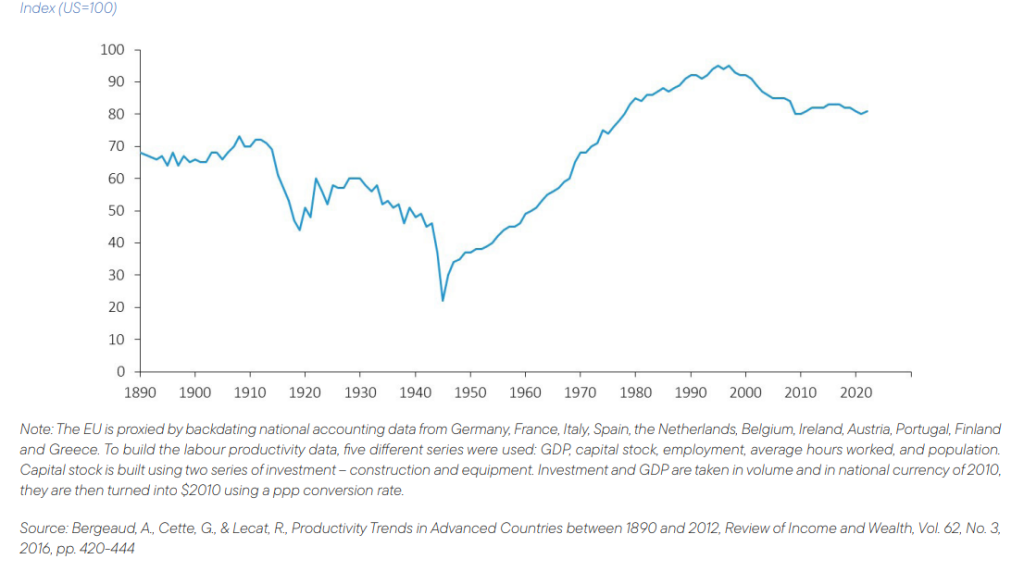Summary
-
Welfare State Expansion: European countries, known for having the largest welfare states within the OECD, are experiencing a decline in economic dynamism as their welfare systems grow.
-
Economic Growth Decline: There is a noted decrease in Europe’s economic growth, productivity, and innovation, attributed to excessive public spending on welfare.
-
Productivity and Innovation: Despite efforts to boost productivity and innovation, Europe lags behind the US and China, particularly in the digital sector. Leaders like Christine Lagarde of the ECB have acknowledged this lag.
-
Reform Proposals: Mario Draghi’s report suggests reforms and investments to enhance productivity while maintaining the welfare state, an approach criticized by Austrian economists for being unsustainable.
-
Government Intervention: Proposed solutions involve more centralization and government intervention rather than increasing economic freedom, which critics argue doesn’t address the core issues of resource allocation and incentives.
-
Public Spending: The welfare state in Europe is significantly large, with public social spending in many countries like France, Finland, Denmark, Belgium, and Italy close to 30% of GDP, far exceeding the OECD average.
-
Efficiency Concerns: Despite high spending, the European welfare model is seen as inefficient, not significantly reducing poverty or promoting economic growth.
-
Political and Economic Implications: The article suggests that without substantial changes to allow for more market freedom and entrepreneurship, Europe’s economic situation might worsen, potentially leading to a welfare state collapse.
-
Philosophical Critique: The narrative critiques the European approach from an Austrian economics perspective, highlighting the tension between economic growth and welfare state expansion.
Article
European countries are the largest welfare states in the OECD and among the highest in the World. At the same time, Europe’s economic dynamism has faded out and European leaders are getting increasingly worried about it. According to Christine Lagarde, the ECB President, Europe’s generous social model is at risk unless the region fixes a persistent decline in growth. In a recent report, Mario Draghi strongly calls for reforms and investments to reinforce productivity growth, while keeping untouched the continent’s oversized welfare state. For Austrian school economists, this sounds like having your cake and eating it too, because the issues of economic growth and income redistribution are intrinsically linked.
Europe’s problem with anaemic growth
Lagarde acknowledges that Europe trails behind the US in terms of productivity growth. Faced with rapid advance in innovation, the EU remained stuck in the “middle technology trap”, while the US and China are spearheading the digital revolution. Europe is falling behind in emerging technologies such as microchips, AI, and electric vehicles and only four of the world’s top 50 tech companies are European.
Draghi’s report on “The future of European competitiveness” reveals that economic growth has been lower in the EU than in the US over the past two decades. The EU – US unfavourable gap in terms of GDP at constant prices has doubled from about 15% in 2002 to 30% in 2023. Around 70% of the gap has been driven by lower productivity in the EU (Graph 1). Moreover, Europe’s growth prospects are not good. The continent enjoys relatively high trade openness, but is now facing strong competition from Chinese exporters and potential high tariffs from the US. On top, EU companies are burdened by high energy costs and European countries will probably need to spend significantly more for defence, adding to already high public spending.
Graph 1: EU vs US labour productivity 
The solutions proposed by Draghi to boost productivity growth and innovation have little to do with increasing economic freedom. They are primarily aiming at centralizing and reinforcing government intervention and keep in place the massive welfare state.
Draghi calls for a new industrial strategy for Europe which should be coordinated at EU level. It may help overcome the current division of policies and financing sources among countries. But it cannot solve the more fundamental issue of inefficient allocation of resources and bad incentives that industrial policies bring about. In a similar way, decarbonisation and new clean technologies cannot reduce the current high energy costs without an economic cost. Current production facilities based on fossil fuels are cheaper and their replacement would increase the cost of doing business. […]
— Read More: mises.org




